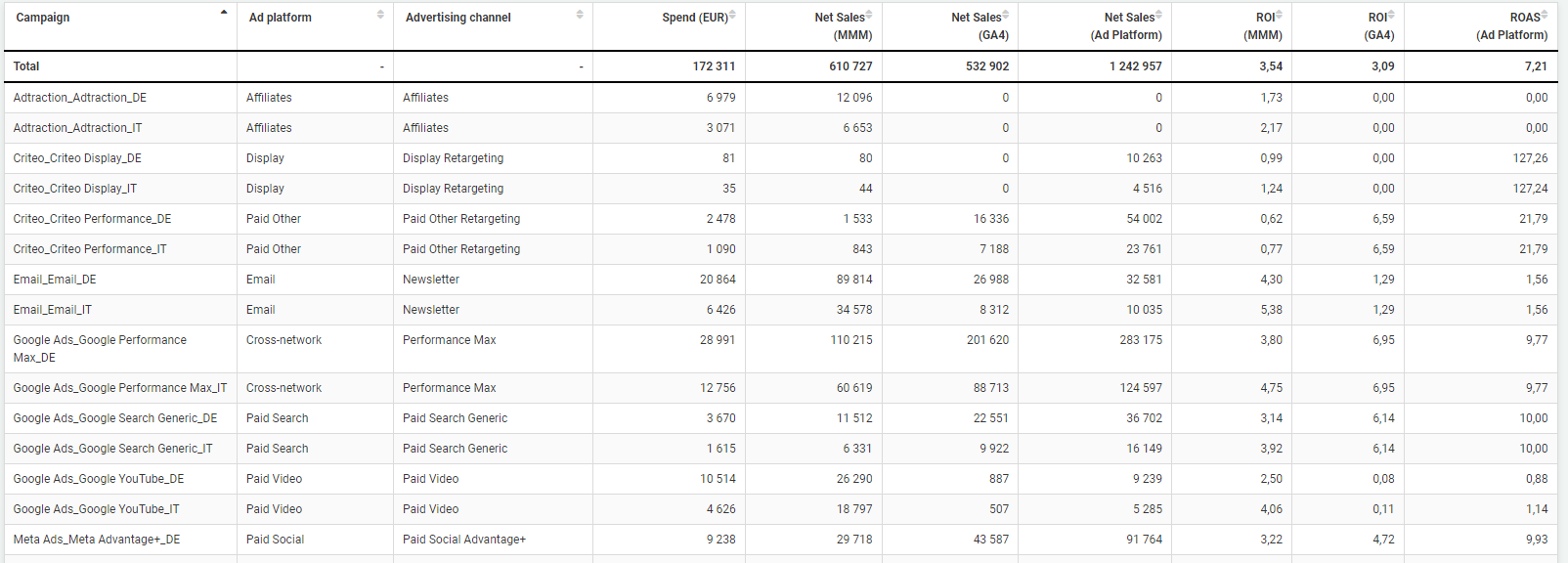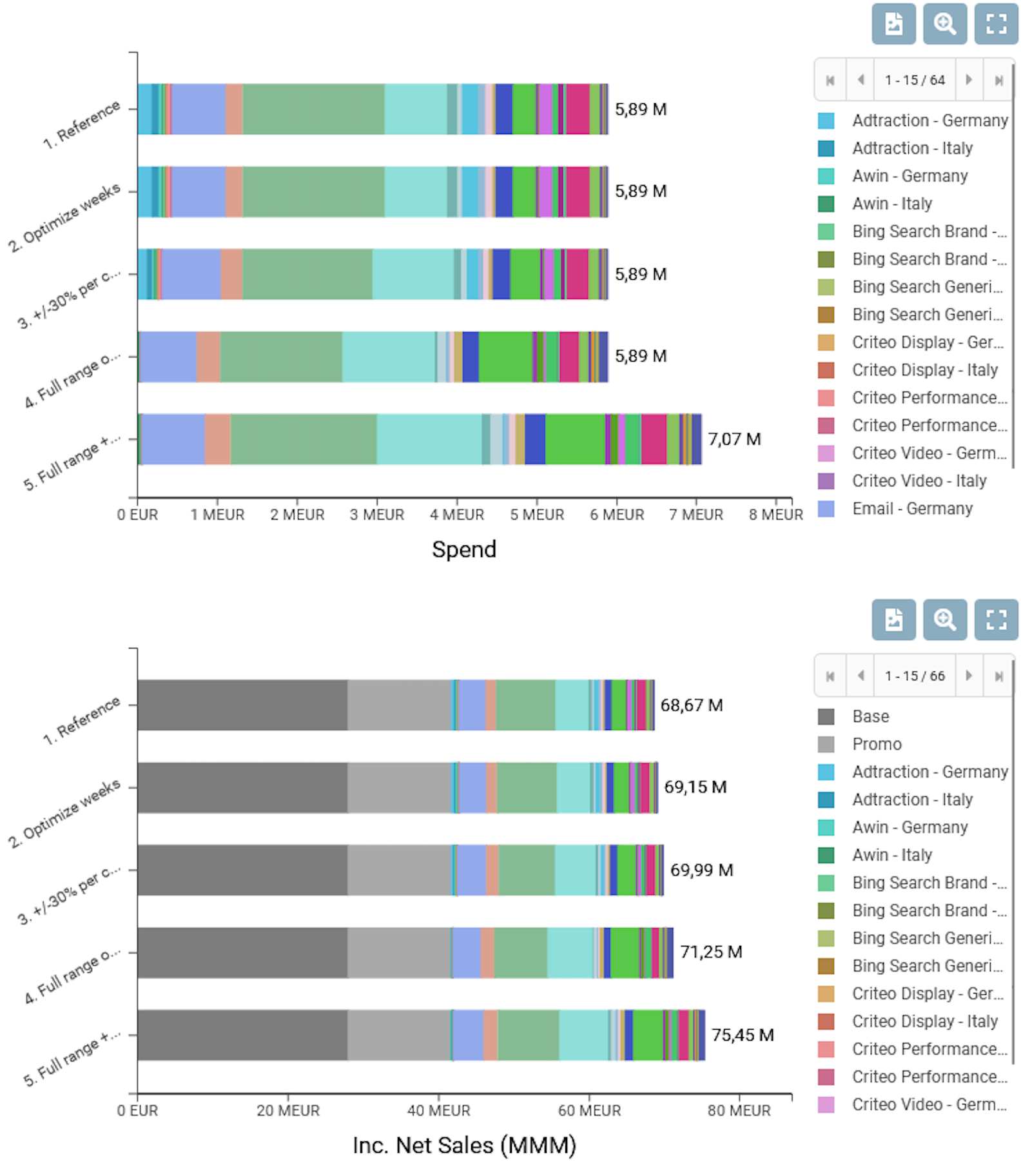Marketing budgeting season is here with five best practices to follow.

As the marketing budgeting season begins, marketers and media agencies face the critical task of allocating resources in a way that maximizes returns and ensures the company can reach its growth objectives. This process is more complex than simply repeating last year’s budget with a slight increase; it requires an approach that considers factors such as the true performance of each media, saturation levels for each media channel, and the sales targets of the company.
In this blog post, we’ll explore five best practices to help you navigate this year’s budgeting process more effectively.
1. Use Incrementality-Corrected ROI/ROAS for Media Comparison
When comparing the effectiveness of different media channels, it’s crucial to use ROI/ROAS metrics that accurately reflect the true incrementality of each channel. Many marketing teams still use last-click attribution or ad platform attribution, but they can be misleading.
For instance, last-click attribution overestimates the ROI of branded search campaigns while underestimating the ROI of upper-funnel media like paid social. This can lead to poor budgeting decisions, such as cutting paid social investments that, in reality, are effective.
As another example, an ad platform could show 4x ROI for retargeting campaigns compared to prospecting campaigns, when in reality, their ROI could be the same when corrected for incrementality. Retargeting campaigns for existing customers have a lower share of incremental conversions since many of your existing customers will continue buying even without advertising.
To avoid these pitfalls, you can measure media effectiveness either with:
- Marketing Mix Model-reported ROI, or
- ROAS metrics that are corrected for incrementality.
Incrementality correction for ROAS can be done by multiplying it with a campaign-specific incrementality factor, which, for example, Sellforte’s marketing measurement solution provides. Below is an example from Sellforte’s platform that shows ad platform and Google Analytics 4-reported ROAS next to Marketing Mix Model-estimated ROI that is based on estimating the true incrementality of the campaign.

These two metrics consider the true value each channel adds, providing a clearer picture of where your marketing dollars are truly making an impact. Using these metrics ensures that your budget optimizations are based on more accurate data, leading to more effective allocation and better overall performance.
2. Understand the Level of Saturation Before Increasing Investments
A high ROI in a particular channel might suggest it’s a good candidate for increased investment, but this isn’t always the case. The level of saturation in the marketing activity is a key factor that can influence whether additional spending will yield sufficient returns in the future as well. For example, while your branded search campaigns might be delivering a high ROI, they could be approaching saturation—meaning additional investment may not significantly increase returns. At the same time, a channel like PMAX might show a slightly lower ROI but offers ample room for scaling, making it a better candidate for increased budget allocation.
To make informed decisions, it’s essential to assess the saturation level of each channel. This can be done by analyzing marginal ROI and response charts, which indicate how much more return you can expect from additional investment in a given channel. Understanding these dynamics will help you allocate your budget where it has the most potential for growth, rather than simply following high-level ROI figures. Below is an illustration of a response chart:
3. Ensure Budget Sufficiency to Meet Next Year’s Sales Targets
Don't create a budget that is doomed to underdeliver. This can happen especially with eComs & DTC brands, which have ambitious growth targets, but their planning process is strongly anchored to last year's budget.
To avoid this, use a planning tool that forecasts total sales based on your proposed media budget. Below is an example from Sellforte Media Optimizer that shows a sales forecast with different budget scenarios.

4. Pace Your Budget Appropriately Throughout the Year
Proper budget pacing is a critical but often overlooked aspect of budget optimization. Allocating your budget evenly throughout the year is an assumption we have seen in many MMM-based budget optimizer solutions, but it can lead to major inefficiencies. For example, overinvesting during periods of naturally low demand can be wasteful, while underinvesting during peak periods can result in missed opportunities.
To optimize your budget pacing, use a planning tool that accounts for seasonality and other business-specific dynamics. This tool should help you identify the best times to invest heavily and when to scale back, ensuring that your budget is used most effectively throughout the year. Below is an example from Sellforte’s Optimizer, showing optimal weekly allocation to each media.
5. Build Realistic Budget Scenarios for CFO Discussions
When presenting your budget to the finance team, it’s important to come prepared with well-thought-out scenarios that align with your organization’s financial goals. Each scenario should include:
- Media Allocation by Channel: Show how you plan to distribute the budget across different media channels, based on their performance and potential.
- Pacing Throughout the Year: Outline how the budget will be spent over the course of the year, taking into account seasonal variations and other factors.
- Expected Total Sales: Provide a forecast of total sales, with a breakdown of media-driven sales, to demonstrate the expected impact of your proposed budget.
Consider these scenarios as starting points for your discussions with the CFO:
- Reference #1: What sales can be achieved with the same budget and mix as last year?
- Reference #2: What sales can be achieved with the same budget but with an optimized mix and budget pacing?
- Sales Target Optimization: How much budget is needed to meet next year’s sales target, considering different levels of risk. For example, you could have a low risk scenario, where the mix is similar to last year, and a higher risk scenario where you change your mix drastically, but can save money as it is more optimized
- Overdelivery Plan: How much budget would be required to exceed sales targets by a certain percentage?
By providing these scenarios, you not only demonstrate your understanding of the financial implications of your budget but also build a strong case for the resources you need to achieve your goals.
Conclusion
Budgeting season is a critical time for marketers and media agencies. By using incrementality-corrected ROI/ROAS metrics, understanding channel saturation levels, ensuring budget sufficiency, pacing your budget appropriately, and building realistic scenarios for discussions with finance, you can create a budget that supports your organization’s growth objectives and maximizes your marketing ROI. Start planning strategically now to set the stage for a successful year ahead.
Curious to learn more? Book a demo.

You May Also Like
These Related Stories

Why these 3 Marketing Mix Modeling Myths are wrong?



